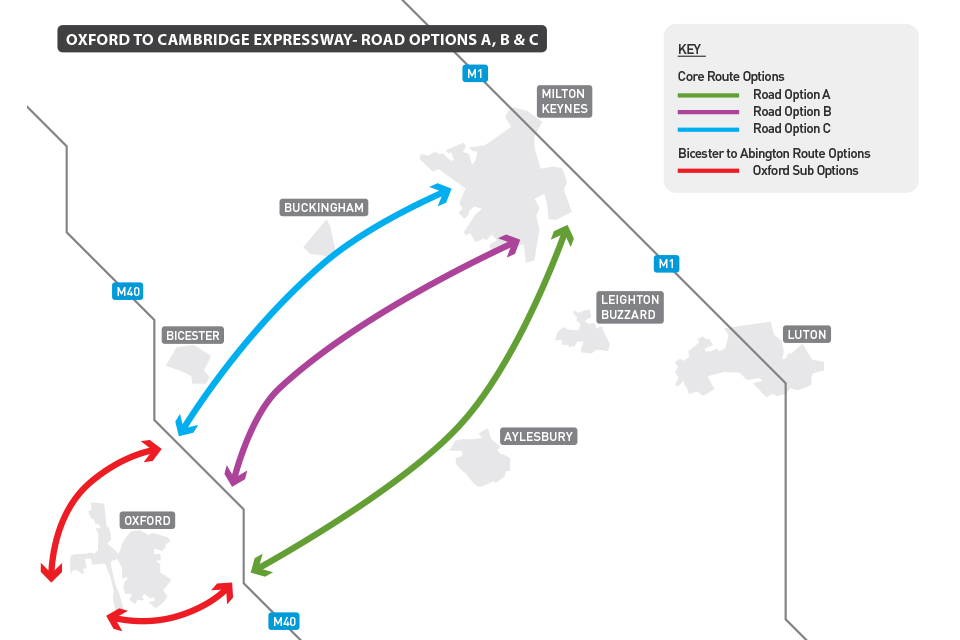The Oxford-Milton Keynes-Cambridge Expressway
The Oxford-Milton Keynes-Cambridge Expressway aims to improve the current weak transport links to connect the top cities in the Golden Triangle.

A new expressway has the potential to deliver economic growth and uplift to the benefit of the UK, while cutting commuter journey times by up to 40%.
The Varsity Line
The Varsity Line is a railway route that was used to link the English university cities of Cambridge and Oxford. Since sections of the original Varsity Line were closed in 1967, the links between Oxford and Cambridge have been complex to navigate, slow and a hindrance to the area’s growth.
What is the Oxford to Cambridge Expressway?
The Oxford to Cambridge expressway is part of a broader, national transformation of UK infrastructure, starting with the establishment of a route that links existing roads and develops new ones. The expressway is planned to be a grade-separated dual carriageway between Oxford and Cambridge via (or in the surrounding area of) Milton Keynes.
Because of the weak connection that currently exists between Oxford, Milton Keynes, and Cambridge, three of the fastest growing cities in the UK - building a road linking the two cities is vital to the area's growth.
40% increase in travel demand expected by 2035
According to the National Infrastructure Commission (NIC), for Britain to succeed in the global economy, it needs to build on its strengths, one of which being the corridor:
The corridor connecting Cambridge, Milton Keynes and Oxford could be the UK’s Silicon Valley – a world renowned centre for science, technology, and innovation. But its future success is not guaranteed.
The steady growth in investment in business and property in these and other growing sectors and the subsequent development of the expressway could mean a horde of new commuters making use of the new expressway.
According to the Oxford to Cambridge Expressway study:
There is expected to be around 40% increase in travel demand by 2035, with associated worsening of congestion on the existing primary east-west road route, resulting in reduced journey time reliability and increased journey times.
With more people moving to the cities of Oxford, Cambridge, and Milton Keynes, transport routes, including the new expressway, is likely to still result in longer travel times. This is why the development of the east-west rail link connecting to Addenbrooke’s Hospital, Cambridge South, is a welcome proposal while also helping to drastically reduce journey times between Cambridge and Oxford.
What is the brain belt?
The Brain Belt has been popularly used to describe the talent (brain) in the Cambridge and Oxford areas, while the ‘belt’ refers to the transportation – a corridor that connects the talent to surrounding areas.
With Cambridge University producing the most sought-after graduates in Britain, the £7billioncost of the expressway could be a wise investment in securing growth in the UK’s brain belt.
The Times Higher Education’s (THE) annual world university report ranked universities around the world for employability in 2017, and found:
Cambridge University graduates have the best employability in the UK
Cambridge is also the fifth best university for graduates in the world (behind the Massachusetts Institute of Technology (MIT), Columbia University, Harvard University, and California Institute of Technology)
Oxford University ranked 15th overall
Imperial College London ranked 17th overall
The impact on housing
If developing housing was recognised as a core target for this scheme, the expressway could support the significant housing growth in the western area of the corridor from Milton Keynes to Oxford. This was affirmed during the Autumn Budget, when Chancellor Philip Hammond pledged to build a million new homes along the corridor between Cambridge and Oxford.
New towns could be constructed along the route to provide for the one million new homes, which could be constructed by 2050. It is estimated by the NIC that the project could contribute £160billion a year to the region’s economy.
Prediction for area growth because of new transport links
While the brain belt is already Europe’s largest life sciences cluster, businesses not primarily focused on science academia or research could also see new opportunities for business growth and talent acquisition in the newly established hub.
The expressway could enhance connectivity within the Golden Triangle of Cambridge, Oxford, and London, while internationally, it will help drive growth and investment in UK science, technology, and other top industries.
As the Chairman of the NIC, Lord Adonis, put it:


